By Jason and Alisha Hagey
Three works, each a facet of the same radiant mosaic, make Utah Presents: Ballet Hispánico a captivating journey through the vibrant pulse of Latinx identity at Kingsbury Hall. The company dances not just with precision but with purpose. From the meditative fervor of Buscando a Juan to the surreal allure of House of Mad’moiselle and the intoxicating blaze of Club Havana, the performance is a potent cultural reflection, stunning, and deeply poignant.
With a silence so intense it resembles prayer, Buscando a Juan begins. The stage is waiting for a memory to transpire on its surface, spectral apparitions to become living flesh. At the back of the stage, hanging fabric evokes the sweep of a painter’s brush or the sails of a ship.
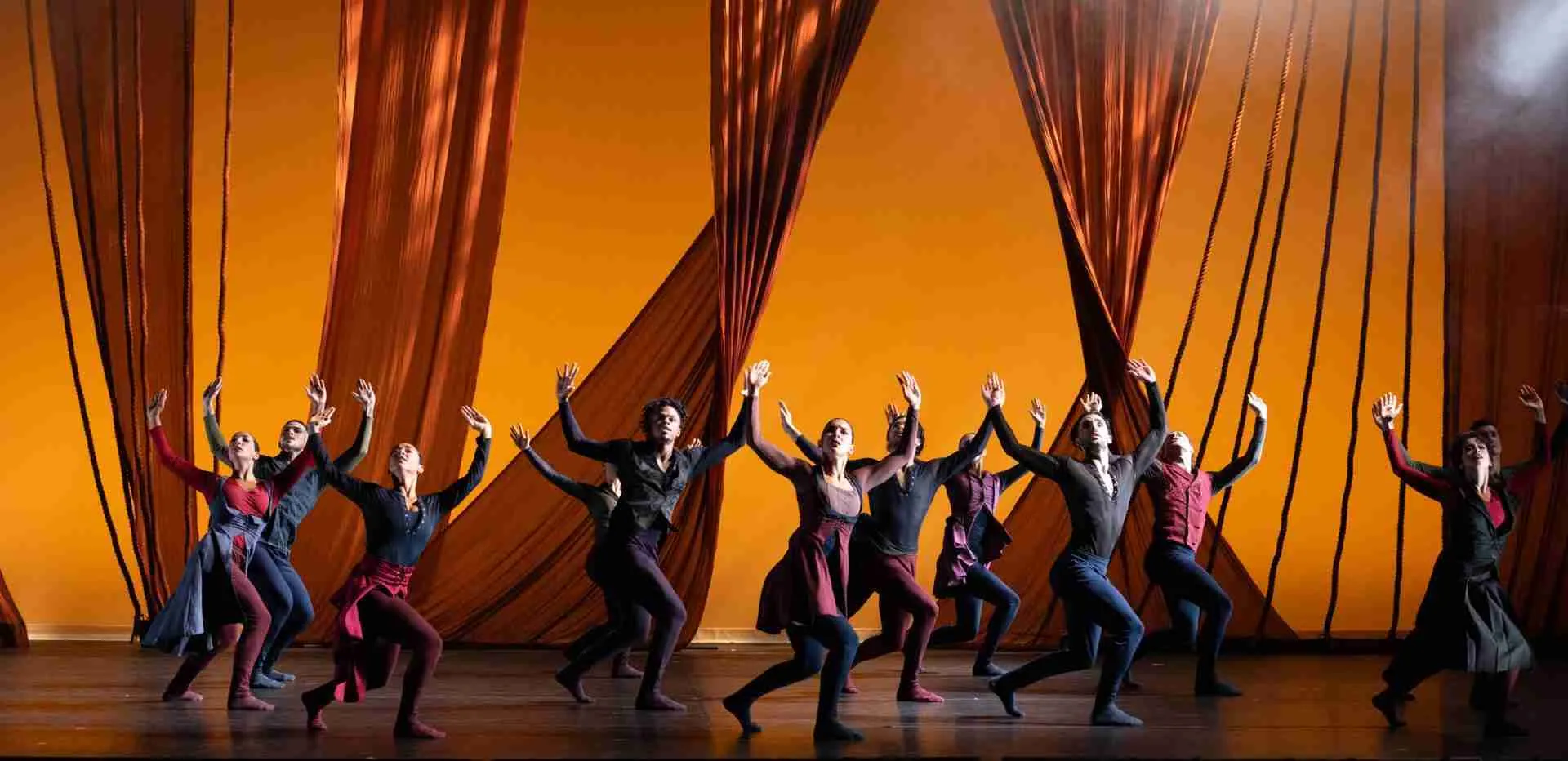
Thrumming beneath it all with liturgical percussion, Osvaldo Golijov’s (Composer) music produces a sacred beat, like a heartbeat. The music drives the choreography through tides of oppression, revelation, and ecstatic belief. There are moments of silence where the only sounds are the defiant movements of the dancers as they continue to writhe and ripple, move and pulse, as if the flow of blood through veins.
Light becomes its own dancer. Sometimes, Christopher Ash’s (Set and Lighting Designer) lighting isolates a figure in what seems a revelation. At other times, the lighting cloaks the stage in monastic shadows. Each shift feels like judgment or mercy.
Eduardo Vilaro’s (Choreographer) meditation feels timeless. His work is suspended between ancestry and invention. Every gesture bears intent. Bodies coil in stillness before unspooling into sudden, searing grace. Vilaro is not just narrating Pareja’s biography, but also capturing his essence. Through movement, Vilaro reveals the artist and the believer. His choreography exposes the fetishized, fragmented, revered, and erased brown and black body, then reclaims it as its own act of creation.
Amir J. Baldwin (Juan de Pareja) and Antonio Cangiano (Diego Velázquez) create invisible calligraphy with their bodies in their pas de deux. Baldwin’s enslaved painter and Cangiano’s enslaver distill centuries of power and yearning into motion. Their bodies weave dependence and defiance into a tense geometry of touch. Theirs is a choreography of ownership, ownership undone, and effulgent empathy.
Around them, the dance company undulates like water. Their movements are sometimes subtle, sometimes broad. They take the viewer on a journey with Juan de Pareja. The ensemble fractures and reforms. They reflect the never-ending conflict between the self and the collective. They give a fiercely dedicated and technically flawless performance. Their movements are intensely expressive and physically demanding. The choreography is elevated from steps to pure emotion by the dancers.
The whole dance’s meaning is captured in the duet “The Calling of Juan.” Francesca Levita and Baldwin converge to create what amounts to an elegy of awakening. Their bodies are moving in a slow, deliberate unveiling. The silent affirmation of individuality, the evolving fortitude, is a beautiful illustration of how dance can be a vital historical and cultural reflection.
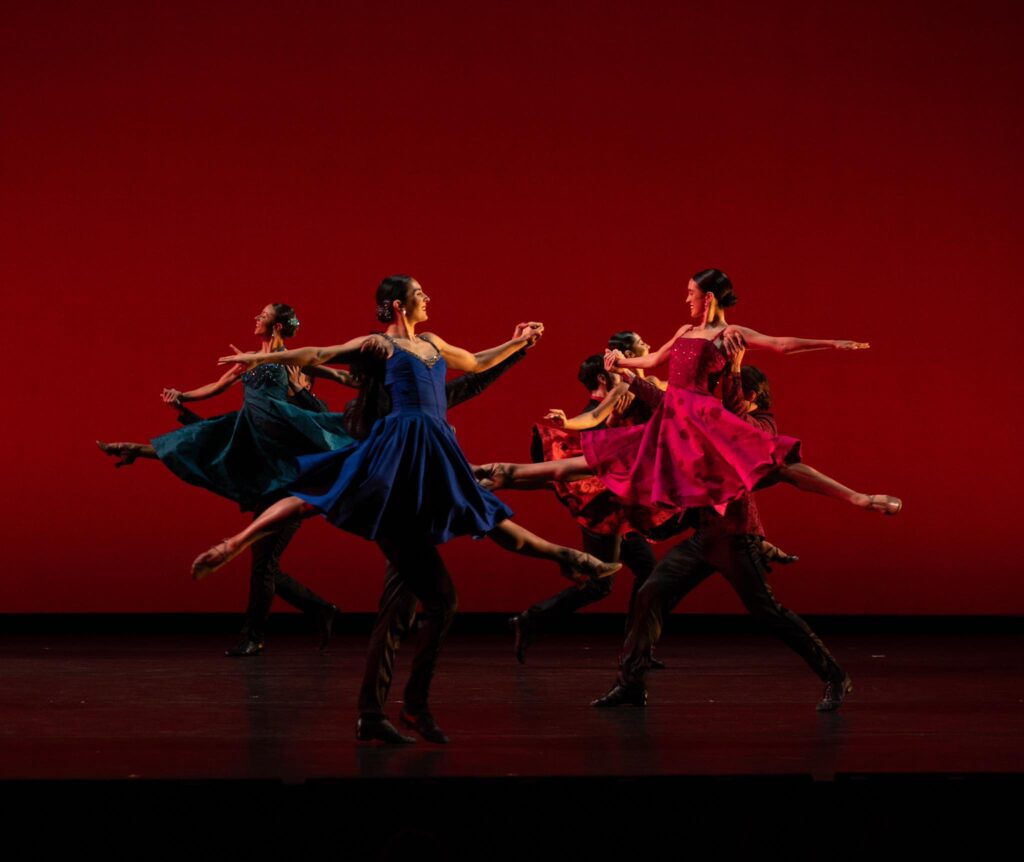
In House of Mad’moiselle, Annabelle Lopez Ochoa (Choreographer) conjures a world where movement becomes poetry and sound becomes memory. The choreography is fluid and fiercely expressive. Each gesture is its own language of resistance and identity.
Mia Bermudez (Maria) is astounding. Bermudez moves with a power that is both sensual and commanding, her body carving through space with ease. Each motion is infused with intention. Her power and control are always on display. She commands attention, finds moments of levity, and effortlessly transitions between female archetypes.
In addition to individual genius, House of Mad’moiselle thrives on the group’s overall synergy. The dancers move in unison, each one sensitive to the piece’s emotional undertones as well as the choreography. They imbue small gestures with meaning. The way they move a palm, arch a back, and fondu, is breathtaking. The company, comprising Amanda Bacallao, Amir J. Baldwin, Mia Bermudez, Thierry Blannchard, Antonio Cangiano, Francesca Levita, Dylan Dias McIntyre, Andrea Mish, Amanda Ostuni, Omar Rivéra, and Olivia Winston, is mesmerizing. Something about emerging from a lift into a plié is a surprise.
What sets this piece apart is its evocative soundscape, built not just on traditional music but on vocalized percussive sounds. Bart Rijnick (Soundscape) uses the cries of “Maria” to create a visceral atmosphere, as if the stage itself were alive and responding. The inclusion of hand fans is evocative. The fan clacking is almost startling, but effective in pulling you into the narrative.
Again, Christopher Ash’s lighting is miraculous. When the lights descend during the “Ave Maria” and it transforms into a Ziegfeld Follies pastiche that is somehow moving and powerful, the audience can genuinely see the complete vision of Ochoa. The myth and the memory come together in a brilliant collision. This piece is a poetic and provocative meditation on power, femininity, and transformation.
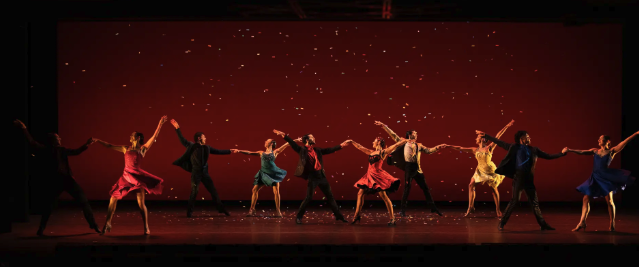
Smoking a cigar should never be sexy, yet Pedro Ruiz’s (Choreographer) opening scene to Club Havana does just that.
Beginning slow and sensual, Club Havana starts like the effervescent bubbles of a bottle of champagne. Once the music gets shaking, the cork bursts onto the stage, and the dancing is unstoppable. It’s Ballet Hispanico’s exuberant signature piece.
Club Havana is part love letter and part fever dream. Not only is it an invitation to lose oneself in the rhythm-drenched nights of pre-Revolution Cuba, but it is a toe-tapping, body-moving escape for the audience.
Donald Holder (Lighting Designer) causes the stage to glow with amber, carmine, and gold. The colors are lush; they seem to radiate the Cuban heat. Emilio Sosa (Costume Designer) gives the women jewel-toned dresses that flicker like flame and the men sleek suits imbued with automatic confidence. Light rolls across the stage in smoky waves, catching sequins, sweat, and shadows alike. Spotlights carve out couples only to dissolve them back into the crowd.
Conga, rumba, mambo, and cha-cha music (composed by Israel Lopez, Rubén Gonzales, A.K. Salim, Pérez Prado, and Francisco Repilado) propels the dancers into euphoria. The company is passionate, sensual, and steamy. With the change of the lights, their steam explodes, and the dancing kicks into high gear and never looks back. Every movement tells a story, and the dancers do it all as if they were born doing it.
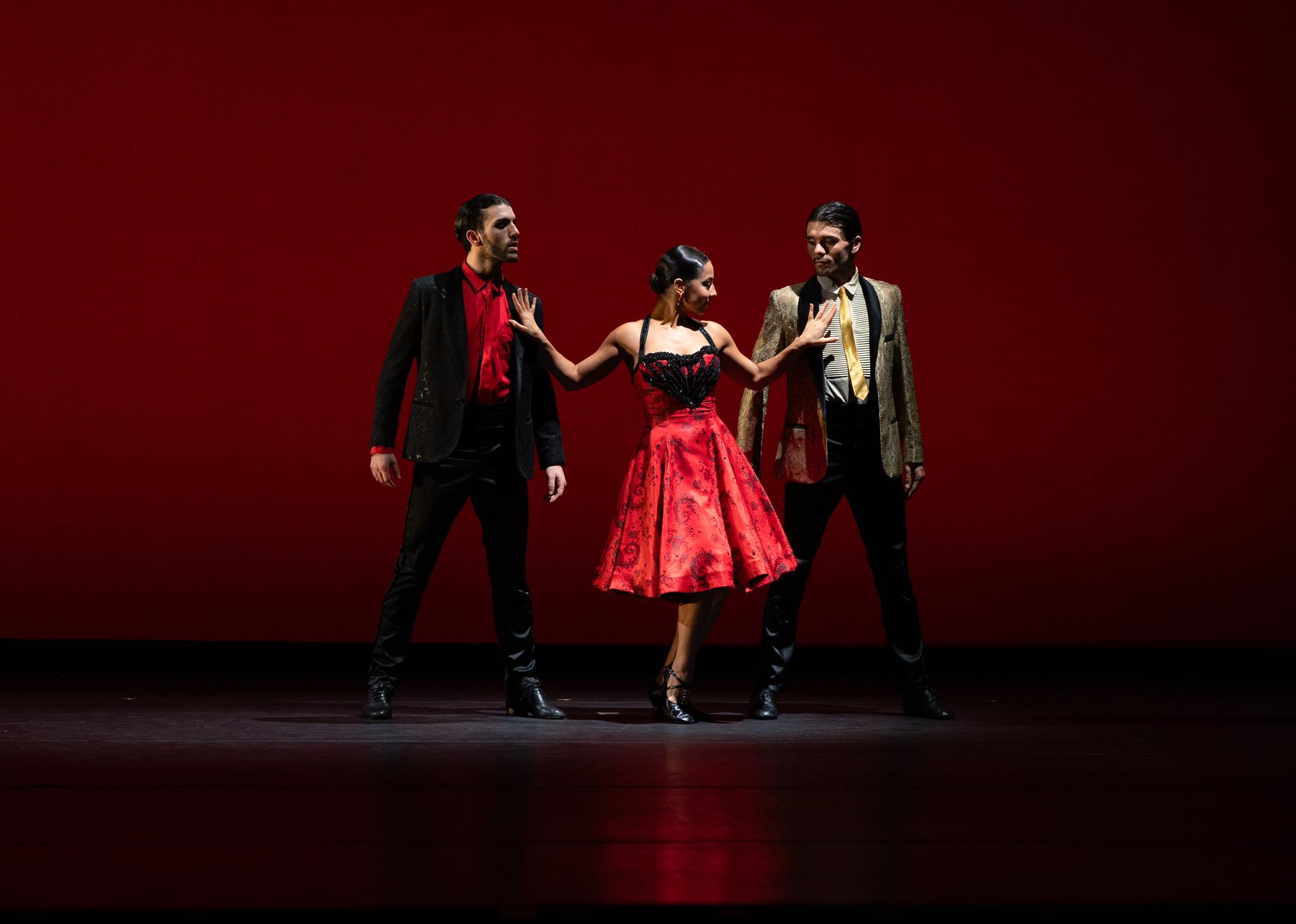
Ruiz choreographs like a man remembering home through action. His vocabulary fuses the rooted cadence of Afro-Caribbean ritual with the precision and sweep of ballet. Every lift feels like flirtation suspended midair. Dancers come and go, their interactions fleeting but fierce, representing romance, competition, and longing. Ruiz reclaims the nightclub as a hallowed place where individuality dances into reality and archetypes (the ferocious seductress, the sleek caballero) are reinvigorated as equals in radiance and rhythm. Club Havana doesn’t just celebrate life; it insists upon it, pulse by pulse, until the curtain falls.
Ballet Hispánico is an immersive experience. The dancers give a performance that is intensely beautiful, filled with meaning in every beat, breath, and look. The artistry and discipline are demonstrated by their ability to strike a balance between explosive intensity and exquisite control. Through their performance, dance transforms into an unapologetic, exquisite, and incredibly human language of truth. This isn’t folk dance, nor is it singularly traditional ballet; Ballet Hispánico is an unforgettable celebration of movement and culture that will amaze.
Runtime: 120 minutes with two 15-minute intermissions
UtahPresents, Ballet Hispánico New York
Kingsbury Hall, Eccles Theater, Libby Gardner Concert Hall
1395 Presidents’ Cir, Salt Lake City, UT 84112
October 15, 2025
7:30 PM
Tickets: Utah Presents
Ballet Hispánico
Utah Presents Instagram
Utah Presents Facebook
Coming Soon:
Lakecia Benjamin and Phoenix; October 23, 2025 7:30 pm
Kurbasy; November 5, 2025 7:30 pm
UtahPresents, the performing arts presenter at the U of U, offers a mix of creativity and culture that is at the cutting edge of arts programming. The new season of UtahPresents, based at the iconic Kingsbury Hall on the U of U campus, showcases a total of 19 exciting performances. Whether your love is dance, theater and story telling, music, jazz, or an eclectic mix of them all, UtahPresents has shows for every taste.
Building on previous presenting seasons at Kingsbury Hall, UtahPresents launched in 2015 with a new brand and mission focused on community engagement and enrichment. Now, UtahPresents is celebrating 10 years of programming, having presented close to 2,000 artists from 37 countries and served nearly one million people, including 75,000 K-12 students. In addition to student matinees and public performances, UtahPresents offers masterclasses, community workshops, performance opportunities for young artists and more.
As UtahPresents’ programming has grown over the past 10 years, the organization is always committed to making the arts affordable. UtahPresents’ total compensation for artists more than doubled from 2015 to 2025, yet the average ticket price remains under $25. U of U students can access all UtahPresents’ performances for just $5 with their UCard (Arts Pass).

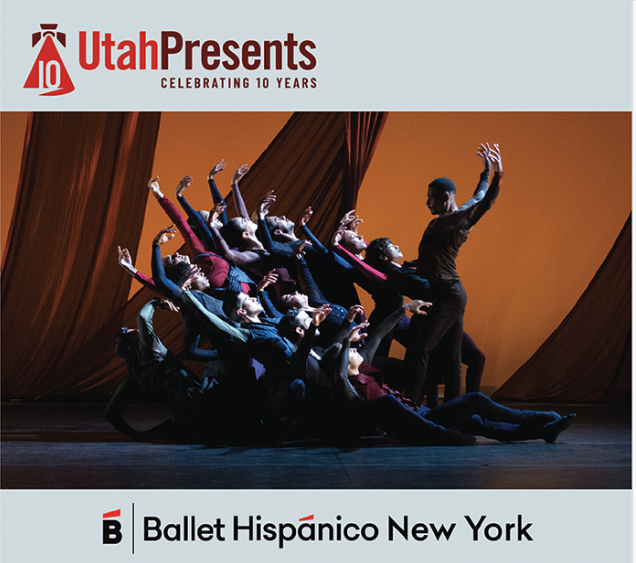
0 Comments